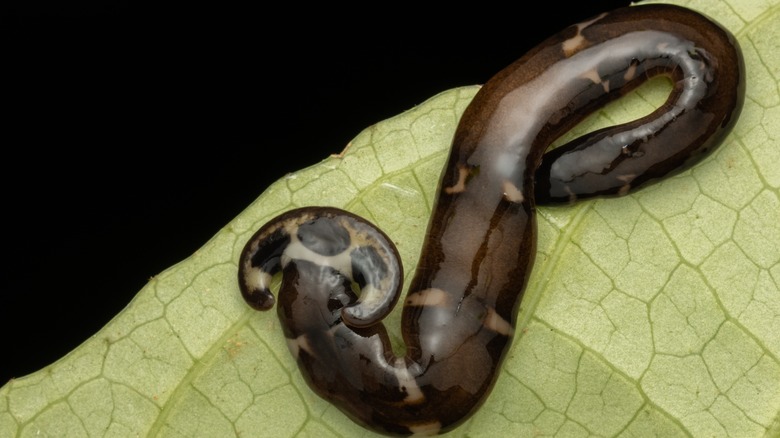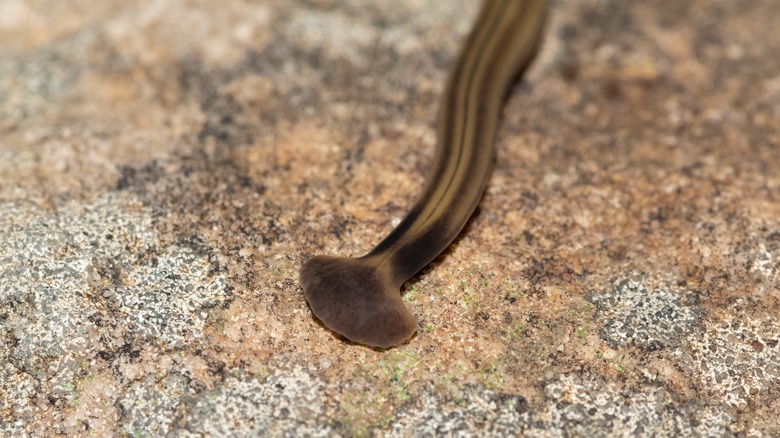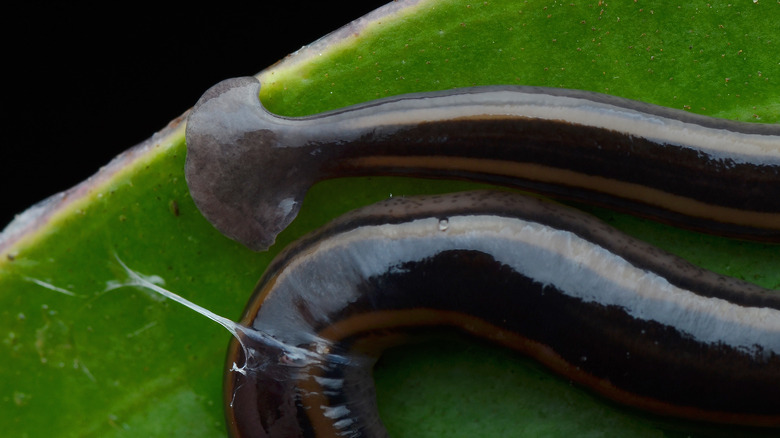The Unsettling Reason You Should Never Squish A Hammerhead Worm
When we think of worms, we typically think of earthworms. But there is such a thing as a hammerhead worm, which looks a heck of a lot more interesting than your typical grub. Before you get too intrigued, however, it's probably worth bearing in mind that these unique-looking worms are actually toxic, and perhaps even more unsettling is the fact that if you cut them, they will simply multiply in a process that sounds like something out of a sci-fi movie.
As the name suggests, the hammerhead worm's most distinctive feature is its head, which closely resembles that of a hammerhead shark and ... well, a hammer. They are a type of land planarian (Geoplanidae) and belong to the subfamily Bipaliinae, sitting within the genera Bipalium and Diversibipalium. Hammerhead worms are common in tropical regions around the world, but there are also at least 15 species in North America. Some of those are considered native, but many are considered invasive and potentially destructive pests, including the Bipalium kewense species which is thought to be native to Indo-China but has been present in the United States for over a century. This particular species, which is also known as the shovel-headed garden worm, is thought to have been introduced to the U.S. in 1891 and has spent the years since proving itself to be a threat to native species, preying on earthworms and impacting ecosystems. But there are several other species of hammerhead worm causing similar problems in the United States, and all of them can regenerate from fragments of their bodies.
A worm with a head like a shark that can regenerate when injured like some sort of worm version of the T-1000 Terminator sounds like a pretty terrifying creature. Luckily, unlike Robert Patrick's legendary cyborg antagonist, these worms can be killed in relatively simple ways. Whatever you do, though, don't cut or squish them.
Hammerhead worms can form new worms from broken off body parts
Hammerhead worms can be brightly colored, but in the United States, they are typically yellow-brown in color with dark stripes running the length of their bodies. The creatures can also grow to over a foot in length, just in case they weren't already creepy enough. Even more unnerving (and remarkable) is the fact that these resilient creatures can not only regenerate damaged body tissue, but they can produce new versions of themselves from broken off pieces of their bodies — unlike earthworms, which can reproduce via parthenogenesis but which can't form new worms from fragmented body parts.
Often, parts of the worms' tails will break off while they travel through the soil, with the pieces transforming into a new hammerhead worm within days. This is a process known as asexual fissioning or fracturing, and it's a problem when it comes to controlling the population of hammerhead worms, especially since they are considered leading predators, preying upon multiple types of invertebrate including snails, slugs, and earthworms while facing very little threat from other creatures.
In short, squishing or cutting hammerhead worms is about the worst possible way to try and kill the pests. What's more, the toxin these pesky planarians secrete is the same one found in pufferfish and is used to incapacitate prey. But it can also irritate human skin and cause sickness in pets who eat the worms — though there haven't been any serious injuries from hammerhead worms reported as of yet. As such, it's always advisable to use gloves when handling hammerhead worms. But if we shouldn't cut them up, how are we supposed to dispose of them?
How should you kill hammerhead worms?
On August 6, 2025, the Maine Department of Inland Fisheries & Wildlife posted on Facebook, warning residents that hammerhead worms had been seen multiple times in recent years and that they could pose a threat to Maine's natural resources, impacting soil and native plants. Thus far, sightings of the species Bipalium adventitium have been confirmed in the state, but the Northeastern United States is home to multiple different Bipalium and Diversibipalium species, including the Bipalium kewense. Regardless of the specific species, the department urged residents not to "squish or cut" the creatures as "that's how they multiply." Instead, it offered alternative ways to dispose of the hammerhead worm on its website, where it suggests placing them in a bag and freezing them for up to 48 hours. Alternatively, you can leave the worms in soapy water, or a 1:1 mixture of water and bleach. Salt, vinegar, or citrus oil can also be used to shrivel up hammerhead worms.
It's not entirely clear how much damage these hammerhead worms have or will cause to natural environments, with some experts believing the threat to be relatively minimal since the worms have been present on U.S. soil for well over a century. Still, as a 2022 study published in the journal Diversity and Distributions notes that while the threat posed by invasive hammerhead worms isn't "immediately obvious," the expansion of their range in non-native habitats is concerning due the fact they prey on earthworms, which play a crucial role in ecosystems.
According to the Early Detection and Distribution Mapping System, the shovel-headed garden worm in particular is present in multiple states throughout the south eastern United States, with sightings also confirmed in California and Washington state. But with the invasive worm making its way to Maine, residents should certainly be on the look out — just don't squish or cut them.


